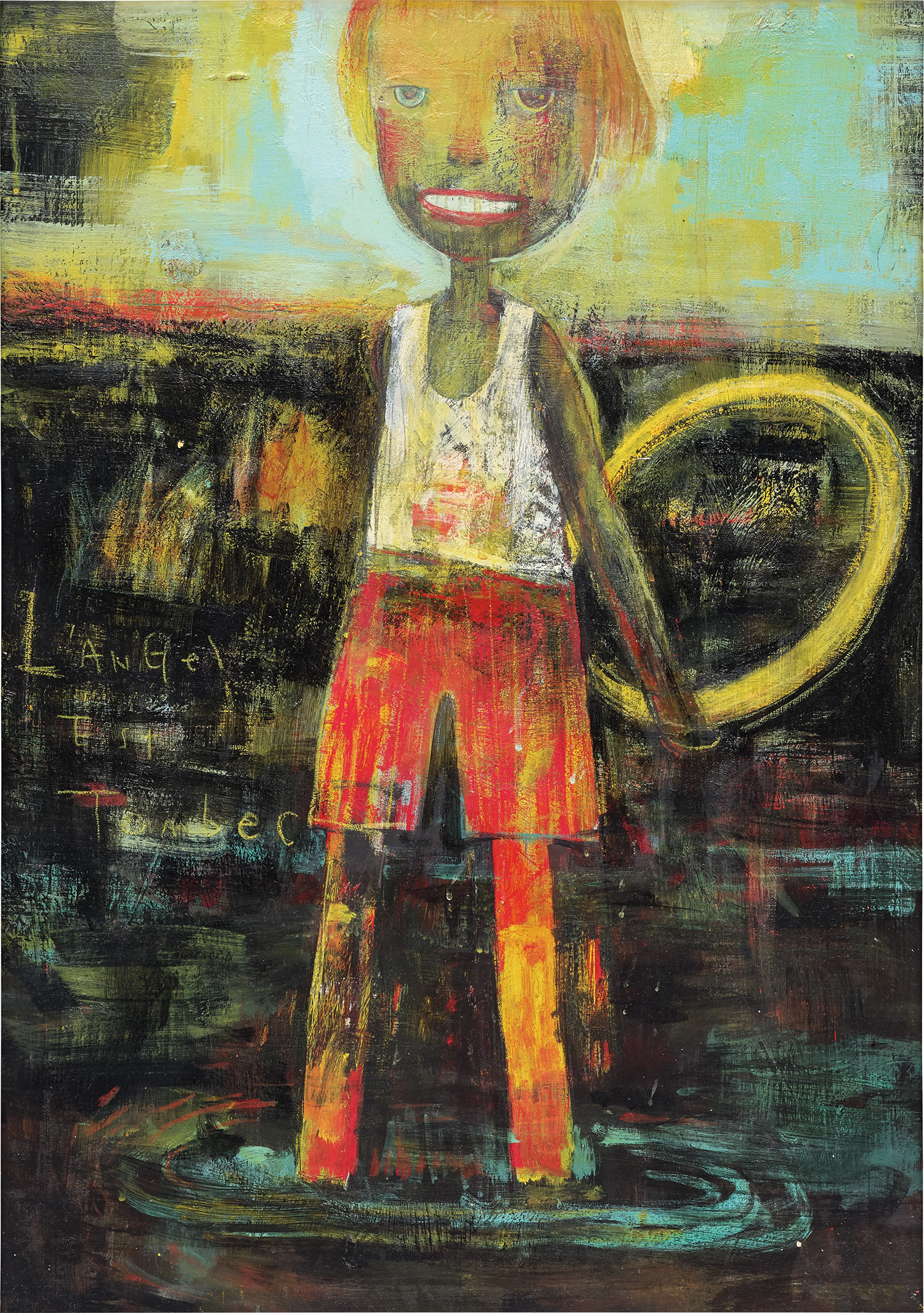

10
Yoshitomo Nara
L’Angel est Tombée
titled, '"L’Angel est Tombée"'; further signed, titled and dated '"L’Angel est Tombée" Yoshitomo NARA 1987' on the reverse
acrylic on board
73 x 52 cm (28 3/4 x 20 1/2 in.)
Painted in 1987.
Full-Cataloguing
In this lot, a fallen angel stands alone in an expanse of dark water. It is a young, gender-ambiguous child with tawny hair, wide eyes and a cryptic smile. Melancholic blue ripples emerge as it wades into the foreground, a once brilliant halo held behind its back like a redundant prop. In this early piece, Nara’s signature style is already becoming evident. The angel is painted with an equivocal expression, foreshadowing the iconic look of his later portraits. Nara is known for reconciling memories of his lonely childhood with the realities of adulthood, often combining the innocent façades of his child-characters with dark motifs. This juxtaposition would eventually be labelled kimo-kawaii, ‘disgusting-cute’, a Japanese fad of adorable things contrasted by cynical elements. In L’Angel est Tombée, we see the beginnings of this theme; however, it is not expressed through kitsch. Instead, feelings of despondence and urgency are tackled with a unique sensitivity.
The composition is submerged by black acrylic with streaks of orange, yellow, and blue. These moments of colour interject the darkness like ephemeral reflections on a moonlit lake. Whilst the enshrouding black is reflective of vulnerability and fear, the angel’s position is steadfast, expressing resilience and determination in the face of whatever may come. L’Angel est Tombée was painted on the cusp of a pivotal transition for Nara, marking the start of a seminal period of artistic development. In 1987, he was a part-time teacher growing discontent with his progression as an artist. Inspired by his pupils, Nara recounts, “I needed to become a true art student” (Yoshitomo Nara, “Nobody’s Fool.” in Yoshitomo Nara: The Complete Works. Volume 1: Paintings, Sculptures, Editions, Photographs, Tokyo, 2011). The following year, he would move to Germany to begin his studies at Kunstakademie Düsseldorf, and remain there until the turn of the century. To this regard, the narrative of a fallen angel lost on mysterious lands can be considered allegorical of Nara’s apprehensions about the future.
In the early 2000s, Nara gained global attention as part of Superflat- a movement of Japanese artists, including Takashi Murakami and Aya Takano, known for using the flat aesthetics of manga and anime. However, painted over a decade before, this work seems more influenced by painting in the western tradition. Fallen angels are common-place in Judeo-Christian iconography. Nara’s appropriation of this theme suggests he is looking at western art history to renew his inspiration. Furthermore, the style of this piece is evocative of neo-expressionism. Nara’s brushwork is emotive and less calculated, with ‘L’angel est tombée’ scratchily inscribed in broken French. These western influences converge excitingly with Nara’s increasing reference to the aesthetics of Japanese cartoons. As Midori Matsui describes Nara’s early works, “The tension between opposite elements imbued the paintings with psychological complexity and a magical atmosphere”(Midori Matsui. “A Child in the White Field: Yoshitomo Nara as a Great “Minor” Artist.” in Yoshitomo Nara: The Complete Works. Volume 1: Paintings, Sculptures, Editions, Photographs, Tokyo, 2011).
Today, Nara is one of the most popular contemporary artists in the world, having exhibited nearly 40 solo exhibitions since 1984. Pieces such as L’Angel est Tombée are scarce, but more than its rarity, this work is a coveted window into Nara’s formative years, allowing a glimpse into the budding inner-workings of an artist we know and love.
The composition is submerged by black acrylic with streaks of orange, yellow, and blue. These moments of colour interject the darkness like ephemeral reflections on a moonlit lake. Whilst the enshrouding black is reflective of vulnerability and fear, the angel’s position is steadfast, expressing resilience and determination in the face of whatever may come. L’Angel est Tombée was painted on the cusp of a pivotal transition for Nara, marking the start of a seminal period of artistic development. In 1987, he was a part-time teacher growing discontent with his progression as an artist. Inspired by his pupils, Nara recounts, “I needed to become a true art student” (Yoshitomo Nara, “Nobody’s Fool.” in Yoshitomo Nara: The Complete Works. Volume 1: Paintings, Sculptures, Editions, Photographs, Tokyo, 2011). The following year, he would move to Germany to begin his studies at Kunstakademie Düsseldorf, and remain there until the turn of the century. To this regard, the narrative of a fallen angel lost on mysterious lands can be considered allegorical of Nara’s apprehensions about the future.
In the early 2000s, Nara gained global attention as part of Superflat- a movement of Japanese artists, including Takashi Murakami and Aya Takano, known for using the flat aesthetics of manga and anime. However, painted over a decade before, this work seems more influenced by painting in the western tradition. Fallen angels are common-place in Judeo-Christian iconography. Nara’s appropriation of this theme suggests he is looking at western art history to renew his inspiration. Furthermore, the style of this piece is evocative of neo-expressionism. Nara’s brushwork is emotive and less calculated, with ‘L’angel est tombée’ scratchily inscribed in broken French. These western influences converge excitingly with Nara’s increasing reference to the aesthetics of Japanese cartoons. As Midori Matsui describes Nara’s early works, “The tension between opposite elements imbued the paintings with psychological complexity and a magical atmosphere”(Midori Matsui. “A Child in the White Field: Yoshitomo Nara as a Great “Minor” Artist.” in Yoshitomo Nara: The Complete Works. Volume 1: Paintings, Sculptures, Editions, Photographs, Tokyo, 2011).
Today, Nara is one of the most popular contemporary artists in the world, having exhibited nearly 40 solo exhibitions since 1984. Pieces such as L’Angel est Tombée are scarce, but more than its rarity, this work is a coveted window into Nara’s formative years, allowing a glimpse into the budding inner-workings of an artist we know and love.